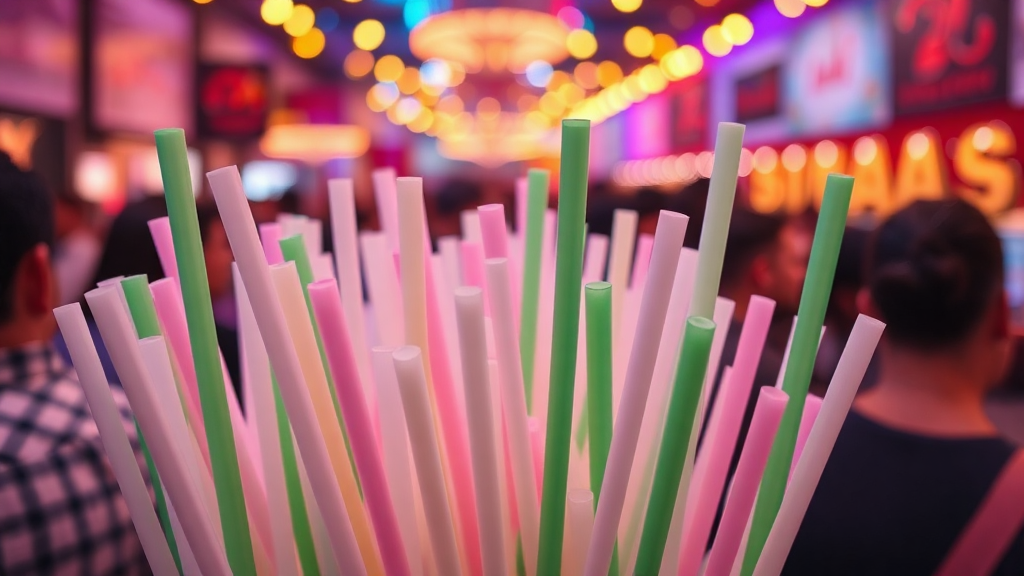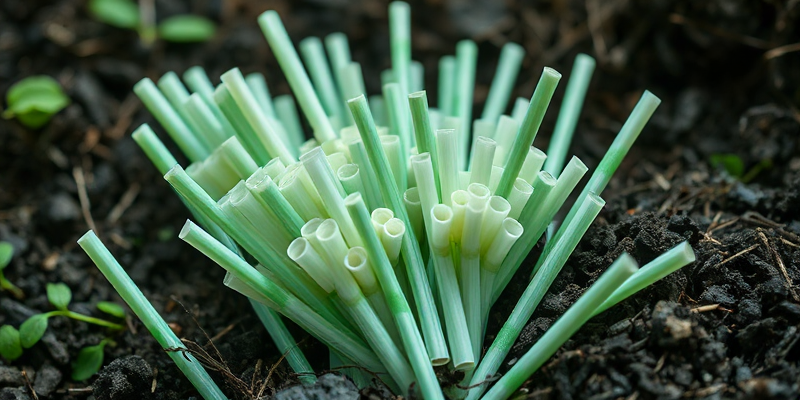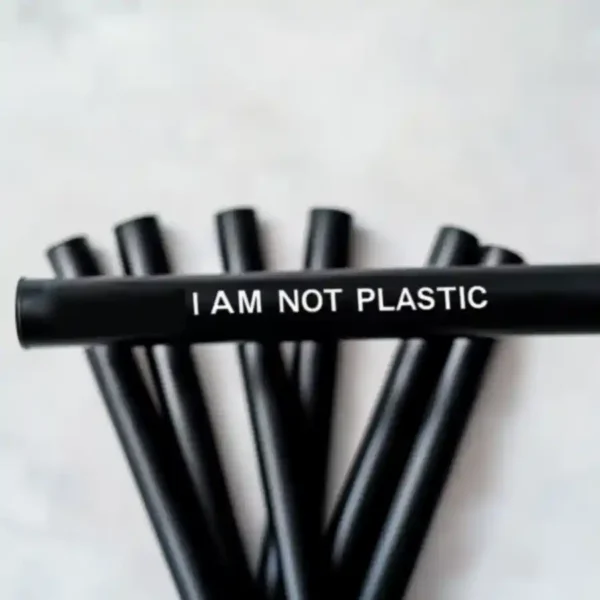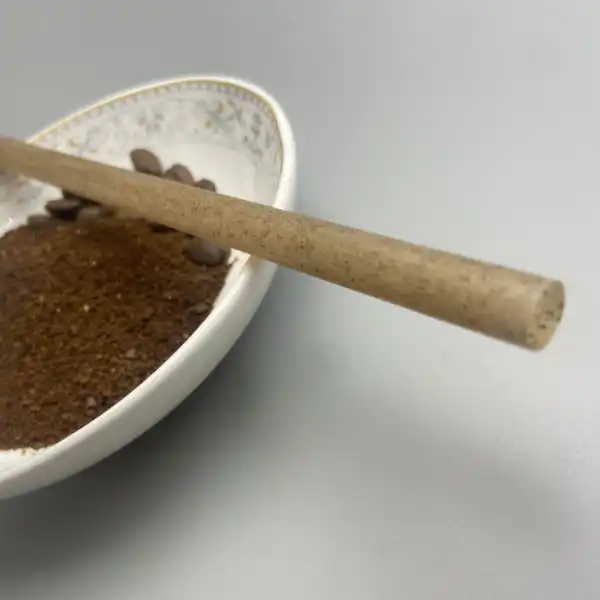Biodegradable Straws for B2B: Compliance, Cost & الاستدامة

Plastic Bans and Biodegradable Straws: The New Busines Reality

Picture this: It’s Monday morning, and you’ve just received an email from local authorities announcing a plastic straw ban effective in 90 days. As a procurement manager for a hotel chain, restaurant group, or distribution company, you’re suddenly facing a major supply chain pivot with significant cost implications. Sound familiar?
This scenario is becoming increasingly common acros the globe. From California to the European Union, single-use plastic regulations are tightening, leaving businesses scrambling for compliant alternatives that won’t break the bank or disappoint customers.
The global shift away from conventional plastics isn’t just a regulatory headache—it’s reshaping consumer expectations. A recent McKinsey study found that 66% of consumers consider sustainability when making purchasing decisions. This means your choice of straws is increasingly becoming part of your brand story.
Explore the full sustainability benefits of sugar cane straws that go beyond mere compliance with plastic bans. These plant-based alternatives offer a compelling narrative for businesses caught between regulatory requirements and operational practicalities.
For B2B buyers, the transition to biodegradable straws involves navigating a complex landscape of certifications, supply chain considerations, and cost-benefit analyses. The initial investment might seem steep—biodegradable straws typically cost 1-3 cents more per unit than conventional plastic—but the long-term benefits extend beyond compliance to include brand reputation, customer loyalty, and future-proofing your busines against increasingly stringent regulations.
As we’ll explore in this comprehensive guide, the biodegradable straw market offers viable solutions for businesses of all sizes. Whether you’re a procurement specialist for a global hotel chain or managing supplies for an independent café, understanding your options is the first step toward making informed decisions that balance sustainability with busines realities.
Regulatory Compliance: Certifications for Biodegradable Straws

Navigating the regulatory landscape for biodegradable food service items can feel like crossing a minefield blindfolded. Different regions, different rules—and the penalties for non-compliance can be severe. In California alone, businesses can face fines of up to $5,000 per day for violations of single-use plastic regulations.
The first certification to look for is FDA compliance, which ensures your straws meet food safety standards. The FDA’s food contact materials regulations require thorough testing to ensure no harmful chemicals leach into beverages, especially under heat or with acidic drinks.
Beyond FDA certification, look for:
- LFGB certification (the European equivalent of FDA approval)
- BPI (Biodegradable Products Institute) certification for compostability
- Home compostability verification (critical for products that claim to break down in backyard composting systems)
- ASTM D6400 or EN 13432 standards compliance (verifying compostability claims)
Discover FDA-certified sugar cane straws available in bulk with customization options to ensure your busines stays compliant while maintaining brand identity.
What makes this particularly challenging for B2B buyers is that many suppliers make vague “eco-friendly” claims without the certifications to back them up. Always request documentation rather than taking marketing claims at face value. When evaluating potential suppliers, ask pointed questions about their certification processes and request copies of actual certification documents.
For businesses operating acros multiple jurisdictions, a universal approach might be necessary. Adopting the highest standards acros your entire operation can simplify procurement and avoid the logistical nightmare of managing different products for different locations.
How Biodegradable Straws Compare to Other Eco Alternatives

Not all sustainable straws are created equal. Understanding the strengths and limitations of each option can help you make the right choice for your specific busines needs.
| بديل | متانة | User Experience | قابلية السماد | Relative Cost |
|---|---|---|---|---|
| ————- | ———— - | —————– | —————- | —————— - |
| PLA Straws | واسطة | Similar to plastic | Industrial only | واسطة |
| القش الورق | قليل | Often gets soggy | ممتاز | Low-Medium |
| Sugar Cane Straws | عالي | Rigid, doesn’t affect taste | بيت & industrial | متوسطة |
| قش الخيزران | عالية جدا | Natural feel, reusable | Slow biodegradation | High (initial) |
| Agave Straws | متوسطة | Natural feel | Good | متوسطة |
| No Straws | ن/أ | Can displease customers | ن/أ | Lowest |
According to the UN Environment Programme’s report on plastic alternatives, the environmental impact of biodegradable alternatives can vary by up to 80% depending on material source, production methods, and end-of-life disposal.
Understand the production costs behind biodegradable straws with our comprehensive guide designed specifically for procurement professionals seeking to make informed decisions.
The often-overlooked factor in this comparison is supply chain reliability. While paper straws might seem like the obvious choice based on cost, their production capacity has struggled to meet global demand, leading to shortages and price volatility. Sugar cane straws, on the other hand, benefit from established agricultural supply chains, offering more stable pricing and availability.
For businesses in humid environments like coastal resorts or tropical destinations, the functional differences between these alternatives become even more pronounced. Paper straws deteriorate rapidly in humidity, while sugar cane and PLA options maintain their integrity longer, reducing waste and customer complaints.
Top Busines Benefits of Switching to Biodegradable Straws
Beyond compliance, biodegradable straws deliver tangible busines benefits that impact your bottom line:
**Enhanced Brand Perception**: A Cornell University study found that restaurants implementing visible sustainability practices saw an average 4.3% increase in customer satisfaction scores. Your sustainable straw choice becomes a visible, tangible demonstration of your environmental commitment.
**Cost Stability**: While petroleum-based plastics are subject to oil price volatility, plant-based alternatives like sugar cane straws typically offer more stable pricing over time. This predictability is invaluable for long-term budget planning.
Explore cost-effective eco straws specifically designed for B2B buyers that balance environmental responsibility with busines practicality.
**Reduced Regulatory Risk**: As regulations evolve, businesses already using compliant alternatives avoid the costs of emergency transitions and non-compliance penalties. Consider it an insurance policy against regulatory disruption.
**Customer Education Opportunities**: Biodegradable straws provide a conversation starter about your broader sustainability initiatives. Many businesses report that simple table tents explaining their straw choice lead to positive customer interactions and improved perception of other aspects of the busines.
**Staff Engagement**: Don’t underestimate the internal benefits. Employees, particularly younger team members, increasingly seek employers whose values align with their own. A 2023 Deloitte survey revealed that 49% of Gen Z and Millennial workers have made employment choices based on a company’s environmental values.
For businesses with outdoor operations, the practical benefits extend to cleanup costs. Conventional plastic straws that escape into landscaping or surrounding areas require labor-intensive removal, while biodegradable alternatives eventually break down naturally, reducing maintenance expenses.
Environmental Impact: Why Biodegradable Straws Win
The environmental calculus of biodegradable straws goes far beyond the “plastic vs. non-plastic” binary that dominates public discourse.
A lifecycle assessment by the University of California found that sugar cane straws produced 79% fewer greenhouse gas emissions compared to their plastic counterparts when accounting for production, transportation, and end-of-life processing. This dramatic reduction stems primarily from using renewable agricultural byproducts rather than petroleum-based raw materials.
Find low-cost biodegradable straws designed specifically for businesses looking to make environmentally responsible choices without compromising their budget.
The water impact is equally significant. While paper straw production requires substantial water inputs, sugar cane cultivation typically relies primarily on rainfall rather than irrigation in major growing regions. This translates to a water footprint approximately 58% smaller than paper alternatives.
For businesses in coastal areas, the marine impact deserves special consideration. Unlike conventional plastics that persist for centuries, properly certified biodegradable straws break down relatively quickly even in marine environments, reducing wildlife hazards.
The composting advantage cannot be overstated. When properly disposed of in commercial composting facilities, certified biodegradable straws convert to soil amendment in 90-180 days, creating a circular economy benefit rather than persisting as waste. Even in landfill conditions, they degrade significantly faster than conventional plastics.
Case Study: Biodegradable Straws Succes in Action
The Ocean Breeze Resort, a 200-room beachfront property in Florida, provides a compelling example of successful biodegradable straw implementation at scale.
In 2022, facing both customer pressure and looming local regulations, Ocean Breeze transitioned from conventional plastic to custom-branded sugar cane straws acros their property. The initial procurement cost increased by approximately $4,200 annually, representing a 130% increase in straw expenses.
Discover durable, compliant, and customizable sugar cane straws for B2B operations that can be branded to enhance your customer experience while supporting sustainability goals.
However, the results quickly justified the investment:
- Customer satisfaction scores related to “environmental responsibility” increased by 22% within three months
- Social media mentions highlighting their sustainable practices rose by 45%
- Bar beverage sales increased by 4.8%, which management attributes partly to the positive messaging around their straw program
The most surprising outcome? Staff turnover in F&B departments decreased by 17% compared to the previous year, with exit interviews specifically mentioning appreciation for the resort’s environmental initiatives.
The resort’s Director of Operations noted: “What started as a compliance exercise has become a defining element of our brand. The customized sugar cane straws with our logo have become almost a signature item—guests actually mention them in reviews.”
The total return on investment, when accounting for increased sales and reduced staff turnover costs, delivered a positive ROI within 14 months—far sooner than the 3-year timeline originally projected.
أسئلة مكررة
- How much more do biodegradable straws cost compared to conventional plastic?
- Typically, biodegradable straws cost 1-3 cents more per unit than conventional plastic straws when purchased in bulk. However, this gap is narrowing as production scales up and plastic prices increase due to regulatory pressures. For a busines using 1,000 straws daily, this represents an additional cost of $10-30 per day, which can often be offset through slight price adjustments or reduced usage strategies.
- Will biodegradable straws hold up in hot drinks?
- Performance varies by material. Sugar cane straws maintain structural integrity in hot beverages for 2-3 hours, significantly outperforming paper alternatives which typically begin deteriorating within 20-30 minutes. PLA straws, however, are not recommended for hot drinks above 105°F as they can begin to deform.
- What minimum order quantities should B2B buyers expect?
- Typical MOQs for biodegradable straws range from 10,000-25,000 units for standard products and 50,000-100,000 for custom-branded options. However, NatureBioEco offers flexible ordering options specifically designed for businesses transitioning to sustainable alternatives, with lower entry points for first-time orders.
- How should we dispose of biodegradable straws correctly?
- Ideally, certified compostable straws should enter commercial composting streams. For businesses without composting acces, even conventional waste disposal represents an improvement over traditional plastics, as properly certified biodegradable straws will break down faster in landfill conditions, though at a slower rate than in composting environments.
- Do biodegradable straws require special storage conditions?
- Most biodegradable straws have a shelf life of 12-24 months when stored in standard dry storage conditions. Excessive humidity can affect paper straws significantly, while PLA and sugar cane options are more resistant to humidity variations. Temperature extremes (above 105°F) should be avoided for PLA options.
- Can biodegradable straws be customized with our branding?
- Yes, most biodegradable straw materials can be customized with logos and branding. Sugar cane and PLA options typically offer the best print quality. Standard customization usually involves simple one-color printing, though some premium options allow for multiple colors or even full-wrap designs.
- How quickly can we expect delivery for bulk biodegradable straw orders?
- Standard products typically ship within 1-2 weeks for domestic orders, while custom options generally require 4-6 weeks from design approval to delivery. Planning ahead is essential, particularly during high-demand periods like the summer months or ahead of new regulatory implementation dates.







